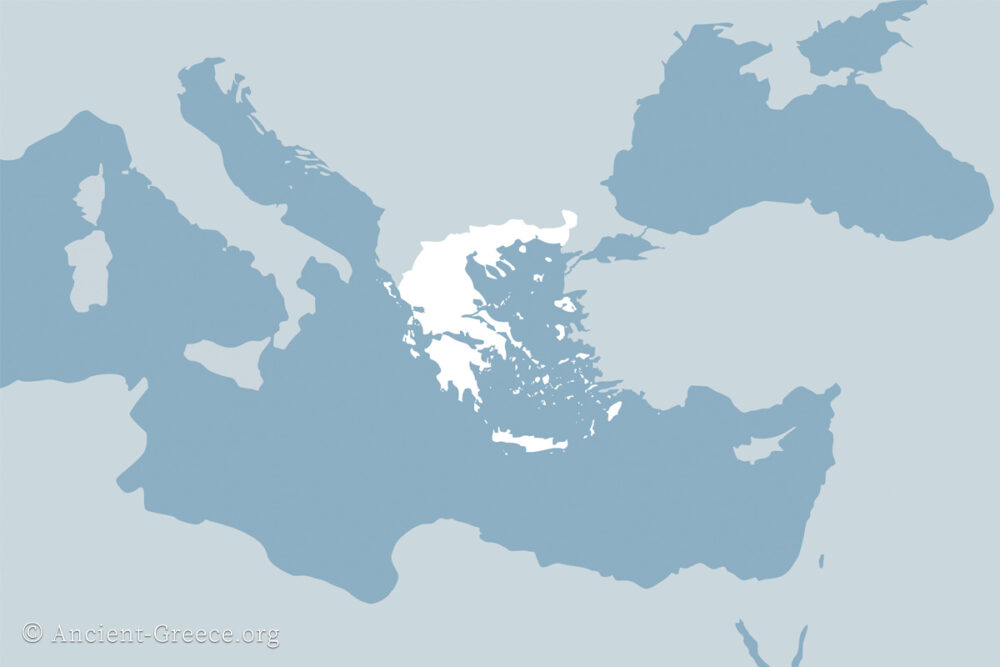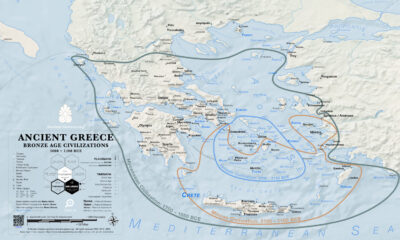
On this page:
Historical Eras
Ancient Greek history is generally divided into the following eras:
Paleolithic (circa 400,000 – 13,000 BP)
Mesolithic (circa 10,000 – 7000 BCE)
Neolithic (circa 7000 – 3000 BCE)
Bronze Age (circa 3300 – 1150 BCE)
Cycladic (circa 3300 – 2000 BCE) in the Aegean islands
Minoan (circa 2600 – 1200 BCE) in Crete
Helladic (circa 2800 – 1600 BCE) on the mainland.
Mycenaean or Late Helladic (circa 1600 – 1100 BCE)
Dark Ages (circa 1100 – 700 BCE)
Archaic (circa 700 – 480 BCE)
Classical (480 – 323 BCE)
Hellenistic (323 – 30 BCE)
Each era had its own unique cultural characteristics, and the transition between them was often tumultuous.
Geography of Greece

The position of Greece at the crossroads between Africa, Asia, and Europe has undeniably played a large role in its diverse and often turbulent history.
Protruding from Europe, Greece hangs precariously southward from the end of the Balkan Peninsula, and slices towards the Mediterranean Sea with dramatic mountain ranges, peninsulas, and thousands of large and small islands.
The Mediterranean Sea offered an easily adaptable climate with mild winters and hot, dry summers, while the rugged mountains and coastline afforded multiple easily defensible positions.
The surrounding sea offered an environment conducive to developing and sustaining enduring civilizations that were relatively safe from casual incursions while able to communicate and exchange large quantities of goods and ideas with ease through the sea lanes.
It is not by accident that the ancient Greek civilization developed around a significant maritime power.
Modern Greek borders confine the country in a much smaller area than in ancient times when Hellenic civilization spread throughout the Mediterranean.
As early as the 7th century BCE Greek influence reached far beyond the traditional mainland, the islands, and the coast of Asia Minor. Hellenic cities and trading posts spread as far as today’s Italy, Sicily, France, Spain, Libya, Crimea, and the entire Black Sea coast as far as Georgia.
With the conquests of Alexander the Great after the fourth century BCE Hellenic civilization attained its widest reach.
During the Hellenistic era Greek culture expanded to include Asia Minor, the Middle East, Egypt, farther East to the Western parts of India, and as far north as today’s Afghanistan.
Chapters
This history of Ancient Greece is divided into the following chapters:
- Timeline
- Introduction
- Overview
- Stone Age
- Bronze Age
- Dark Ages
- Archaic Era
- Classical Era
- Hellenistic Era
Inscriptions by era (Clockwise): Bronze Age Linear A script from 1450 BCE; Early Greek Alphabet from 7th c. BCE; Classical era Ostracon from 5th century BCE; “The Rosetta Stone” from 196 BCE.
Related Pages






